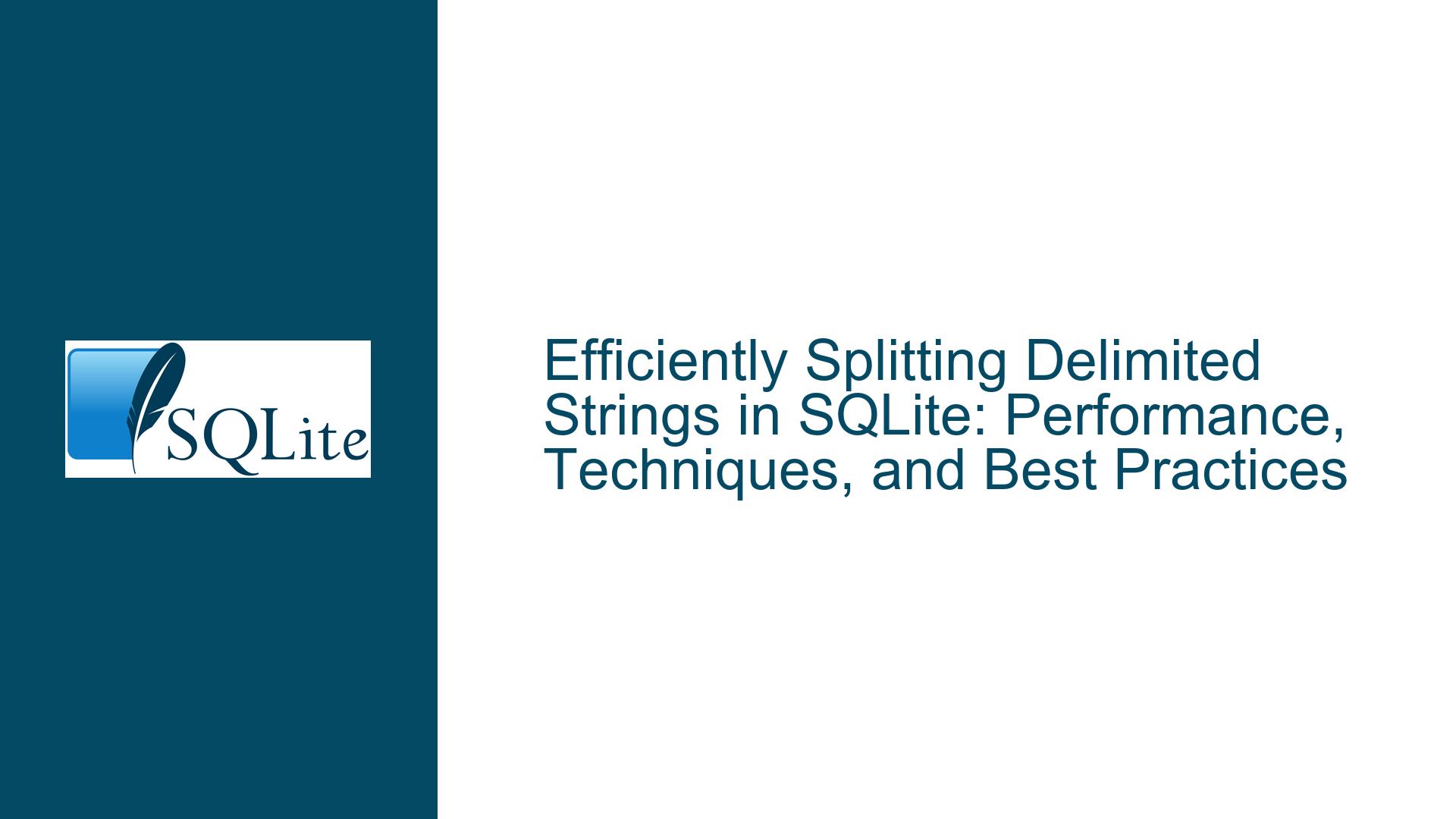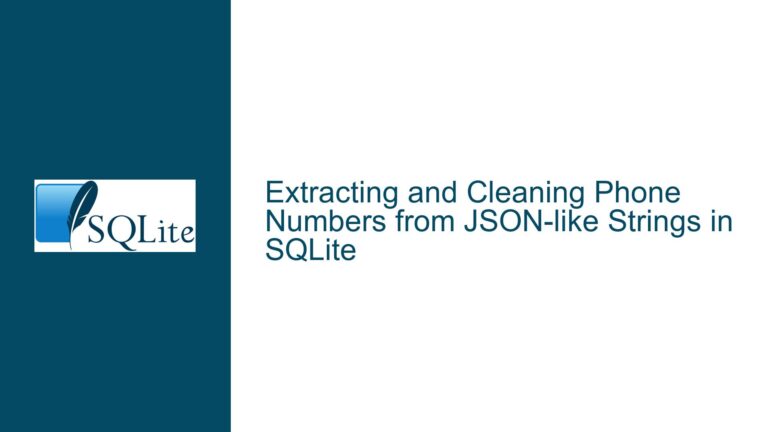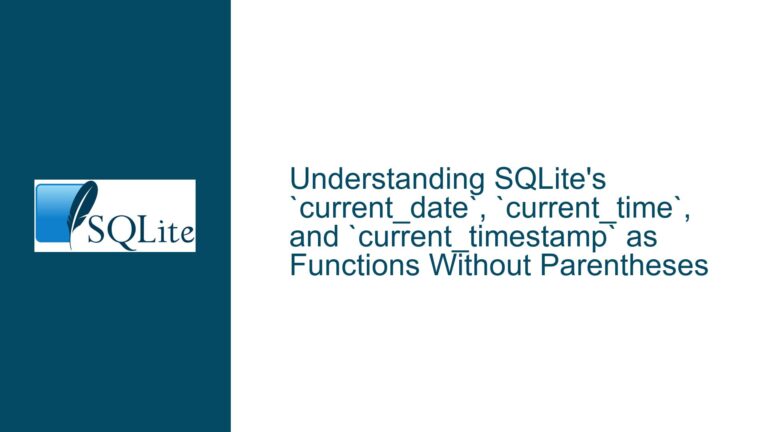Efficiently Splitting Delimited Strings in SQLite: Performance, Techniques, and Best Practices
The Challenge of Splitting Delimited Strings in SQLite at Scale
Splitting delimited strings into individual records is a common yet challenging task in SQLite, especially when dealing with large datasets. The absence of a native STRING_SPLIT function, as found in other database systems like TSQL, forces developers to rely on alternative methods such as recursive Common Table Expressions (CTEs) or JSON functions. While these methods can achieve the desired result, their performance and scalability vary significantly depending on the dataset size, the number of delimiters per string, and the chosen approach. This post delves into the intricacies of splitting delimited strings in SQLite, exploring the underlying issues, potential causes of performance bottlenecks, and actionable solutions to optimize this operation.
Performance Bottlenecks in Recursive CTEs and JSON-Based Approaches
Recursive CTEs are a popular choice for splitting delimited strings in SQLite due to their flexibility and compatibility with the SQL standard. However, their performance can degrade significantly when processing large datasets with many delimiters per string. The recursive nature of CTEs requires SQLite to repeatedly evaluate and process each substring, leading to increased computational overhead. Additionally, the lack of native string-splitting functions means that each step of the recursion involves manual string manipulation using functions like instr() and substr(), which further compounds the performance issues.
On the other hand, JSON-based approaches, such as converting delimited strings into JSON arrays and using json_each(), offer a more streamlined solution. By leveraging SQLite’s built-in JSON1 extension, these methods can efficiently parse and split strings into individual records. However, JSON-based approaches are not without their limitations. Converting large strings into JSON arrays can be memory-intensive, and the performance gains may diminish as the number of delimiters per string increases. Furthermore, the JSON1 extension is not always enabled by default, requiring additional configuration or compilation flags.
Another factor contributing to performance bottlenecks is the storage format of the delimited strings. If the strings are stored in a non-standard or bespoke format, additional preprocessing may be required to convert them into a form that can be efficiently parsed. This preprocessing step can introduce significant overhead, particularly when dealing with large datasets. Additionally, the choice of delimiter can impact performance, as certain characters may require escaping or special handling, further complicating the parsing process.
Optimizing String Splitting in SQLite: Techniques and Best Practices
To address the performance challenges associated with splitting delimited strings in SQLite, several optimization techniques and best practices can be employed. One effective approach is to preprocess the data outside of SQLite, using a programming language like Python to split the strings and insert the results into the database. This method offloads the computational burden from SQLite, allowing it to focus on query execution rather than string manipulation. For example, a Python script can read the delimited strings from a table, split them using the split() method, and insert the resulting substrings into a new table using executemany(). This approach not only improves performance but also simplifies the SQL queries, making them easier to maintain and debug.
Another optimization technique is to use SQLite’s virtual table mechanism to implement a custom string-splitting function. Virtual tables allow developers to extend SQLite’s functionality by defining custom table implementations in C or other programming languages. By creating a virtual table that splits delimited strings into individual records, developers can achieve native-like performance without modifying SQLite’s core code. This approach requires advanced programming skills and a deep understanding of SQLite’s internals, but it offers unparalleled flexibility and performance for specific use cases.
For developers who prefer to stay within SQLite’s built-in capabilities, the JSON1 extension provides a powerful tool for splitting delimited strings. By converting the strings into JSON arrays and using json_each(), developers can efficiently parse and split the strings into individual records. However, this approach requires careful handling of memory usage, particularly when dealing with large datasets. To mitigate memory issues, developers can process the data in smaller batches or use streaming techniques to avoid loading the entire dataset into memory at once.
In addition to these techniques, developers should consider the following best practices when splitting delimited strings in SQLite:
Normalize the Data: Whenever possible, avoid storing delimited strings in the database. Instead, normalize the data by splitting the strings into individual records during the data ingestion process. This approach eliminates the need for runtime string splitting and improves query performance.
Choose the Right Delimiter: Select a delimiter that is unlikely to appear within the data itself. For example, using a pipe (
|) or a semicolon (;) as a delimiter is often safer than using a comma (,), as commas are more likely to appear within the data.Index the Results: After splitting the delimited strings into individual records, create indexes on the resulting table to improve query performance. Indexes are particularly important when the split records are used in joins or filtering operations.
Benchmark and Optimize: Test different approaches to splitting delimited strings on representative datasets to identify the most performant solution. Use SQLite’s
.timercommand to measure query execution times and identify bottlenecks.Consider External Libraries: For advanced use cases, consider using external libraries like
sqlean, which provides additional string manipulation functions, includingtext_split(). These libraries can simplify the SQL code and improve performance, but they require careful evaluation to ensure compatibility and stability.
By combining these techniques and best practices, developers can efficiently split delimited strings in SQLite, even when dealing with large datasets and complex requirements. Whether using recursive CTEs, JSON-based approaches, or external libraries, the key to success lies in understanding the underlying performance characteristics and tailoring the solution to the specific use case.






